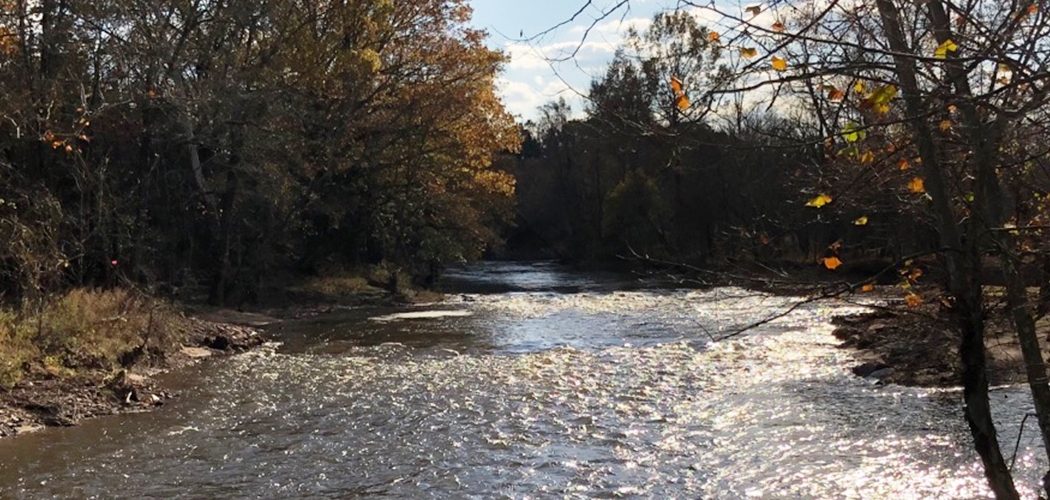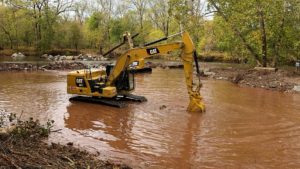An old grist mill dam—dating back to the 1800s—had been removed from the Lamington River in New Jersey, allowing water to run freely and improving habitat for fish and other aquatic creatures.
Removal of the defunct concrete dam was completed in late October by Raritan Headwaters Association (RHA), which owns an 11-acre nature preserve next to the site.
“We are very pleased with how it turned out,” said Dr. Kristi MacDonald, science director for Raritan Headwaters. “Now that the river has been moved back to its original channel we are going to see the ecological health of the river greatly improved.”
She explained that the old concrete dam held sediment, which was not good for most of the aquatic wildlife in the river. In addition, the pooled water behind the dam heated up in summer, depleting oxygen levels. “In our region, we expect to have cool, oxygen-rich water,” Dr. MacDonald said.
The dam removal allows free passage of migrating fish, and the project also added riffles and pools to the river to improve fish habitat.
The dam removal was done in partnership with the U.S. Department of Agriculture’s Natural Resources Conservation Service (NRCS) and the U.S. Fish and Wildlife Service. The dam was located just upstream from the Cowperthwaite-Burnt Mill Road Bridge connecting Bedminster and Branchburg townships.
“Removal of the Burnt Mills Dam is an important step toward restoring the Raritan River and its tributaries to their natural, free-flowing condition,” said Eric Schrading, supervisor for the U.S. Fish and Wildlife Service’s New Jersey Field Office.
“In addition to improving habitat for migratory fish and imperiled mussels, the project boosts water quality and increases public safety in surrounding communities,” he added.
“NRCS is proud to work with our conservation partners to successfully remove the Burnt Mills dam. The completed restoration work will have a sizable ecological uplift to the Lamington River and build upon other NRCS funded stream restoration projects in the watershed,” said Carrie Lindig, NRCS New Jersey State Conservationist.
“NRCS looks forward to working with our partners to continue the momentum of other recent dam removal and stream restoration efforts on northern New Jersey rivers,” she continued.
In addition to taking down the dam, the river was realigned to its historical configuration to reduce erosion and flooding. The main river channel had shifted over the past 60 years to bypass the dam, eroding the riverbank near Milnor Road in Bedminster and causing sediment to muddy the waters.
The project is expected to reduce flooding in the Milnor Road-Cowperthwaite Road neighborhood in Bedminster during storms. The next phases of the project are to plant willow trees near the riverbanks this fall, and restore the floodplain next spring.
“Willows are good in floodplains because they root very fast and help stabilize the stream bank,” noted Bill Kibler, policy director for Raritan Headwaters.
The Burnt Mills dam was one of several along the Raritan River and its tributaries that have been removed in recent years. Others include the Manville Weir in 2010, the Calco Dam in 2011, the Roberts Street Dam in 2012, the Nevius Street Dam in 2013, and the Weston Mill Dam in 2017.
Other major New Jersey dam removals include the Columbia Dam on the Paulins Kill River and the Hughesville Dam on the Musconetcong River, both projects in northern New Jersey that the U.S. Fish and Wildlife Service supported with funding and technical assistance.
In the last decade, the Fish and Wildlife Service has worked with partners to remove more than 660 barriers to fish passage in the Northeast, restoring access to nearly 6,500 miles of river and stream habitat and more than 28,000 acres of lakes, ponds, and wetlands. These efforts have added more than $1.5 billion to the economy, through increased tourism and recreation, improved water quality, and protection of people and property.
Raritan Headwaters, a nonprofit conservation organization, has been working since 1959 to protect, preserve and improve water quality and other natural resources of the Raritan River headwaters region through science, education, advocacy, land preservation and stewardship.
RHA’s 470-square-mile region provides clean drinking water to 300,000 residents of 38 municipalities in Somerset, Hunterdon and Morris Counties and beyond to some 1.5 million homes and businesses in New Jersey’s densely populated urban areas.
All photos courtesy of Raritan Headwaters. Featured photo shows the Lamington River flowing freely again after the dam removal.


